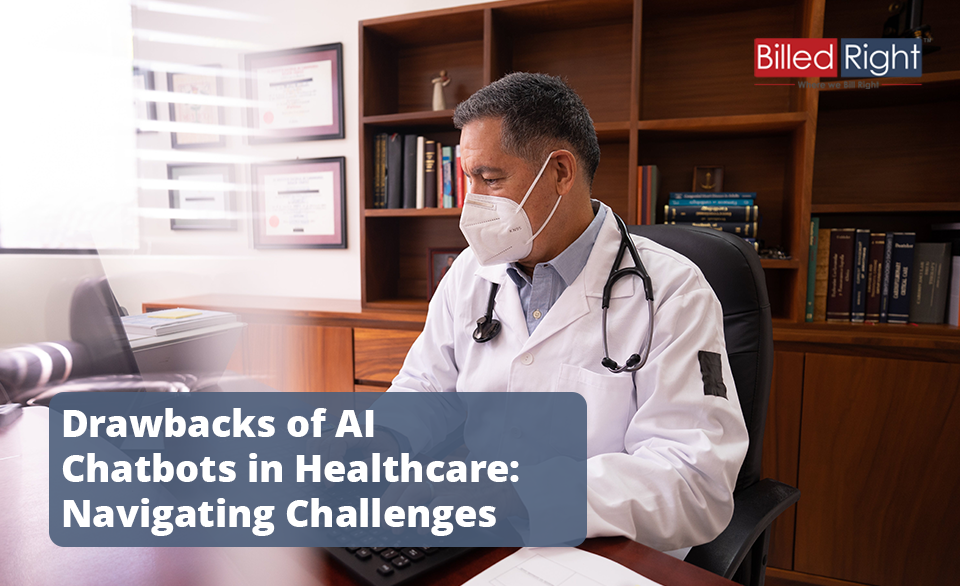Drawbacks of AI Chatbots in Healthcare: Navigating Challenges

Healthcare has been undergoing a transformative journey with the integration of Artificial Intelligence (AI) and chatbots that rose to the mainstream in November of 2022. These digital companions are crucial in streamlining processes, enhancing patient care, and optimizing overall efficiency within medical practices. In this second part of our three-part series on AI in healthcare, we would like to dive into the challenges faced by AI chatbots, complementing the optimistic perspective explored in [Part 1: The Positive Impact of AI Chatbots: Transforming Healthcare]. If you missed it, click here to catch up on AI’s positive strides in the healthcare landscape. Now, let’s navigate the intricacies and drawbacks of AI chatbots in healthcare.
Caution in Healthcare: Why Generative AI Isn’t for Patient Treatment
While AI is super helpful for many things in healthcare, suggesting treatments to patients isn’t one of them. In fact, we strictly recommend that you do not recommend using AI chatbots or any generative AI platforms to give patients any recommendations for their health. Here’s why:
Lack of Personalization
Generative AI operates based on patterns and data it has seen, which is unfortunate because every patient’s health is different. AI might miss crucial aspects and the context of a patient’s situation that human healthcare providers can understand.
Inability to Understand Context:
AI can miss the bigger picture. It might not get why someone feels a certain way or know about their past health issues, which are important for making good healthcare decisions.
Ethical Considerations:
Making medical decisions involves ethical considerations that go beyond data patterns. AI lacks a moral compass and may suggest treatments that raise ethical concerns or violate patient trust.
Legal and Regulatory Risks:
Healthcare decisions are subject to legal and regulatory standards. Relying solely on AI for treatment recommendations may expose practitioners and organizations to legal risks if the decisions do not comply with established guidelines.
Patient-Doctor Relationship:
The patient-doctor relationship built on trust, empathy, and human connection is central to healthcare. Relying on AI alone may erode this vital aspect of healthcare, affecting patient satisfaction and overall well-being.
Ongoing Advancements and Updates:
Healthcare is dynamic, with new discoveries and treatment methodologies emerging regularly. AI may not keep pace with the latest medical advancements, potentially providing outdated or suboptimal recommendations.
Fostering Patient Trust in AI Chatbot Interactions
In healthcare, building trust with your patients is crucial. AI chatbots, while efficient, present a unique challenge in establishing and maintaining patient trust. The absence of human interaction, a foundation of traditional healthcare, impacts patient satisfaction.
Building Trust with AI: AI, devoid of human emotions, can struggle to convey empathy and understanding. Establishing trust involves overcoming this limitation. Transparency in how AI operates and clear communication about its role can contribute to building a foundation of trust.
The Human Touch: Establish an open dialogue with patients about their comfort levels with AI involvement. Encourage questions and address concerns to reinforce AI-assisted healthcare’s collaborative and patient-centered nature.
Overcoming Integration Challenges in Healthcare AI
When strategically implemented, AI chatbots offer immense value in streamlining specific healthcare tasks like appointment scheduling and accessing doctors’ availability. However, integrating these functionalities may still present challenges within your practice:
Easy Appointment Setup:
Make sure the AI chatbot easily fits with the current appointment system. It should play well with different tools to avoid any scheduling problems.
Doctor’s Schedule Compatibility:
Check that the AI understands and updates the real-time availability of our doctors. It needs to work well with their schedules and the systems we already use.
Adjust Workflows for Appointments:
One important process for success is to teach your team how to use AI for appointment scheduling without causing any disruptions. A bit of training can go a long way in making things smoother.
Friendly for Patients:
Make the AI chatbot that you choose for your practice is easy for patients to use when scheduling appointments. It should be simple and straightforward for them to book appointments and check when the doctors are available.
Keep Appointment Info Secure:
Ensure that the AI platform chosen keeps patient appointment info safe and follows rules like HIPAA. This way, we keep things private and maintain trust while using AI for appointments.
By focusing on these simple steps, we can make the AI work well for appointment tasks, making life easier for our team and our patients.
Strategies to Mitigate AI Chatbot Drawbacks in Healthcare
Smart Fixes for Common Problems:
Identify common issues with appointment scheduling and find smart solutions. This helps to solve problems and keep things running smoothly quickly.
Keep an Eye on What’s Happening:
Regularly check how well the AI is doing. Monitoring its performance helps catch any glitches early on, ensuring that appointments and availability checks work without a hitch.
Stay Updated and Upgraded:
Make sure the AI always uses the latest technology. Regular updates help improve its performance, making appointment tasks even more efficient.
Listen to What Users Say:
Pay attention to what our team and patients think about using the AI Chatbot for appointments. Their feedback is valuable in improving and tailoring the system to their needs.
Train and Retrain:
Train our team on any updates and changes in using the AI for appointments. Ongoing training keeps everyone in the loop and helps them make the most out of this useful tool.
In summary, while AI plays a crucial role in many aspects of healthcare, using generative AI for patient treatment recommendations introduces complexities and risks that currently outweigh the potential benefits. It’s smarter to stick with the good old human touch for making decisions about patient health.





